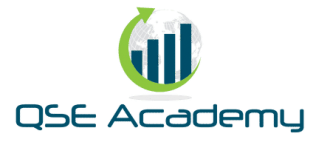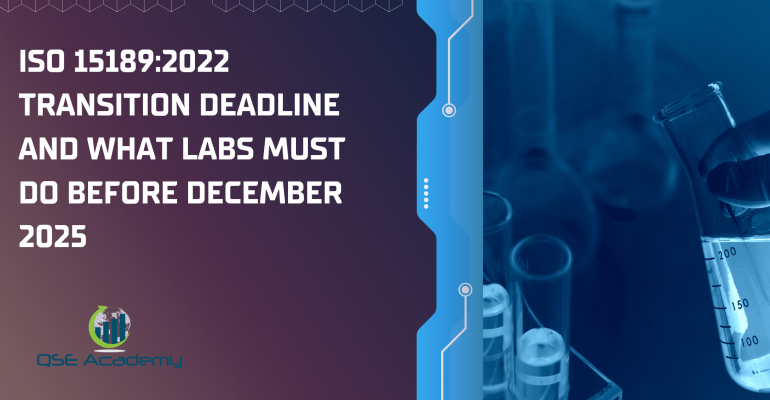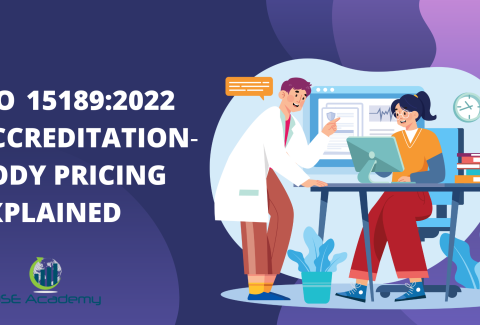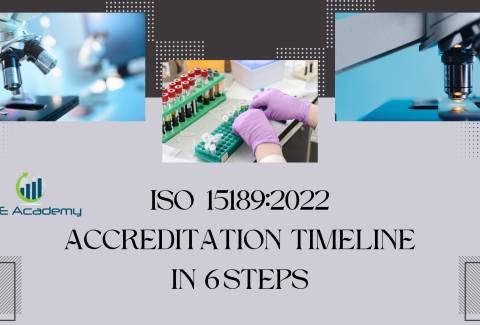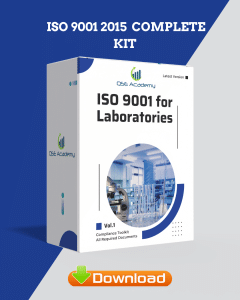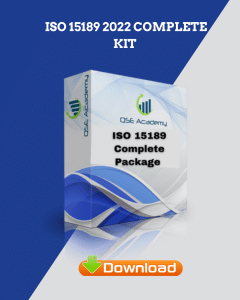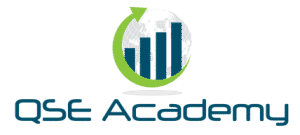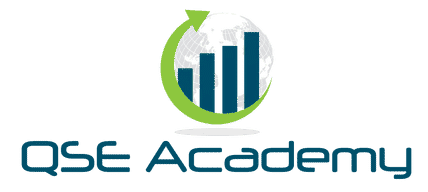ISO 15189:2022 Transition Deadline – Must Do Before December 2025
Last Updated on October 22, 2025 by Hafsa J.
ISO 15189:2022 Transition Deadline and What Labs Must Do Before December 2025
Let’s be honest—if your lab is still operating under ISO 15189:2012, the clock is ticking. You’ve got until December 2025 to make the switch to the updated 2022 version, and I can’t tell you how many labs I’ve worked with who thought they had more time… until they didn’t.
Here’s what I’ve noticed: most labs don’t delay because they’re lazy. They delay because they don’t fully understand what’s changed, what’s required, or how to start. And that confusion? It’s costing them valuable time—and putting their accreditation at risk.
In my experience helping dozens of labs through transitions like this, the ones who move early always have smoother audits, fewer surprises, and a whole lot less stress. That’s why I created this guide.
In the next few minutes, I’ll walk you through the December 2025 transition deadline, break down exactly what’s new in ISO 15189:2022, and give you a step-by-step roadmap you can actually follow—without drowning in technical jargon.
If your goal is to stay accredited, stay competitive, and avoid last-minute panic, you’re in the right place.
Let’s get into it.
December 2025 ISO 15189 Transition Deadline
Here’s the thing—December 2025 isn’t a suggestion. It’s the finish line.
Accreditation bodies across the globe have drawn a hard line in the sand: if your lab wants to stay ISO 15189 accredited, you must transition to the 2022 version before the end of December 2025. No grace period, no partial compliance.
In my experience, the labs that fall behind aren’t ignoring the deadline—they’re just misjudging how long it actually takes to get transition-ready. And by the time they start scrambling to update policies, re-train staff, and fix their documentation, auditors are fully booked and support resources are stretched thin.
Let’s break it down. Most labs need four to six months—at minimum—to do a proper transition:
-
Conduct a full gap analysis.
-
Revise procedures and QMS documents.
-
Train staff and validate understanding.
-
Complete at least one internal audit against the new standard.
If you wait until mid-2025 to start, you’ll be racing against the clock.
This is important because losing accreditation—even temporarily—can disrupt contracts, halt partnerships, and damage your lab’s credibility. I’ve seen it happen.
So here’s my advice: set your internal transition deadline no later than July 2025. That gives you a buffer in case things take longer than expected—which they almost always do.
Want to stay in control? Don’t wait for the deadline to control you.
What’s Actually Changing from ISO 15189:2012 to 2022
Let’s be real—most people assume ISO revisions are just about moving clauses around. Not this time.
ISO 15189:2022 brings real changes, and if you try to treat it like a simple document renumbering exercise, you’re going to miss the point—and probably set yourself up for nonconformities during your next audit.
Here’s what’s actually different:
1. Structure Overhaul
The format now aligns more closely with ISO/IEC 17025 and ISO 9001. That means some familiar clauses have shifted or merged, and you’ll see a stronger process-based structure throughout. It’s cleaner—but you can’t just copy and paste old SOPs into new headings and call it a day.
2. Risk-Based Thinking Is Everywhere
This isn’t just a buzzword anymore. Risk management is now expected in every part of your lab’s QMS—from equipment calibration to document control to patient data protection. It’s not about fear—it’s about foresight.
3. Point-of-Care Testing (POCT) Is Now In Scope
If your lab oversees or performs POCT—even if it’s done by clinical staff outside the lab—you’re now responsible for the quality of that testing. No more treating POCT like a side note.
4. Stronger Focus on Data Integrity and IT Systems
The new standard makes it clear: your information systems matter. If you use a LIS, you’ll need documented validation, access control, and audit trails. This isn’t just an IT problem—it’s a lab accountability issue.
5. Leadership and Competency Expectations Are Higher
Top management has new responsibilities—like promoting a culture of quality and ensuring adequate resources. Plus, you need more detailed, role-specific competence assessments. Annual refresher training isn’t going to cut it anymore.
One of my clients—a hospital-based lab—thought they were “already compliant” because they hadn’t had findings in years. But once we mapped their current QMS to the new 2022 version, we found gaps in staff competence tracking, POCT oversight, and risk documentation. None of it was intentional—but that’s exactly why the new version matters.
This isn’t about adding more work. It’s about making sure your QMS actually reflects how your lab runs today—not how it looked a decade ago.
Step-by-Step Transition Roadmap for Labs
Now that we’ve covered what’s changing, let’s talk about how you actually get this done. Because knowing the new requirements is one thing—implementing them before the deadline is a whole different story.
In my experience, labs that follow a structured plan avoid the panic, stay on schedule, and pass their audits with minimal findings. Here’s a practical step-by-step roadmap I use with clients to move from ISO 15189:2012 to 2022—without flipping their lab upside down.
Step 1: Conduct a Detailed Gap Analysis
Start here. Compare your current QMS against the 2022 version clause by clause. Identify what’s already compliant, what needs tweaking, and what’s completely missing.
Tip: Use a color-coded matrix—it makes progress tracking easier.
Step 2: Prioritize the Critical Changes
Focus first on the new or expanded areas:
-
Risk management integration
-
POCT inclusion
-
Data integrity and LIS validation
-
Competency frameworks
Tackling these early reduces last-minute surprises.
Step 3: Update Your Documentation Strategically
You don’t need to rewrite your entire manual—but you do need to make sure every policy, SOP, and form reflects the new structure and language. Start with key documents like:
-
Quality manual
-
Risk management procedure
-
Document control
-
Training and competency records
-
POCT protocols (if applicable)
One client I worked with revised their top five high-impact procedures first, then rolled out updates department by department. It kept things manageable—and staff engaged.
Step 4: Train Your Team (and Not Just the Quality Manager)
This one’s often overlooked. Everyone in the lab—from techs to supervisors—needs to understand what’s changed and what’s expected. That doesn’t mean full-day lectures. Short, focused training sessions tied to real examples work best.
Step 5: Run a Full Internal Audit Against ISO 15189:2022
Once updates are in place, audit your QMS using the new standard. Treat this like a dress rehearsal. Identify gaps now, while you still have time to fix them. Document everything—you’ll need this evidence for your assessor.
Step 6: Review, Refine, and Submit
After your internal audit, make necessary corrections, review everything with leadership, and prepare for your external assessment or surveillance audit.
One midsize lab I helped followed this exact roadmap and completed their transition in just under four months—with no major nonconformities during their external audit.
The secret? Start early, stay focused, and take it step by step.
Risk Areas That Can Derail Your Transition
Here’s what I’ve seen over and over again—labs don’t usually fail transitions because they don’t care. They fail because they miss the hidden traps. On paper, everything looks fine. But dig deeper, and a few blind spots can throw the whole QMS off track.
If you want to avoid last-minute chaos, here’s what to watch out for.
1. Ignoring POCT Responsibilities
This is a big one. If your lab oversees point-of-care testing—even indirectly—you’re now on the hook for the quality of those processes. A lot of labs still think “that’s nursing’s job.” Not anymore. ISO 15189:2022 clearly puts POCT oversight on the lab’s plate.
Risk: Nonconformity for lack of control or documentation.
2. Underestimating IT System and LIS Validation
Think your IT guy has it covered? Think again. You’re responsible for showing that your LIS is validated, secure, and has proper access controls. I’ve worked with labs that didn’t even realize their audit trail could be bypassed. That’s a problem.
Risk: Major findings for weak data integrity.
3. Copy-Pasting Old Procedures
If you’re just renaming headers and plugging old SOPs into a new format, you’re missing the intent of the revision. Assessors aren’t just checking structure—they’re checking whether your documents match what actually happens in the lab.
Risk: Procedures that look good but fail under scrutiny.
4. Not Updating Competency Frameworks
One of the most common issues I see is outdated or oversimplified training records. The new version expects role-specific, skill-based competence evaluations—not just sign-off sheets.
Risk: Nonconformity for inadequate competence evidence.
5. Leaving Everything to the Last Six Months
This is the silent killer. Even labs with good intentions get stuck in day-to-day operations and push transition work too late. By the time they start, consultants are booked out, auditors are slammed, and it’s too late to course-correct.
Risk: Missed deadline, accreditation lapse, or rushed, error-prone updates.
In my experience, the labs that succeed are the ones that treat transition like a live project—not a side task. Weekly check-ins. Assigned owners. Real deadlines. That’s what gets results.
Common Mistakes and FAQs
Even with the best intentions, I’ve seen labs trip over the same few issues again and again during ISO 15189 transitions. These aren’t dramatic failures—they’re the kind of things that seem small until they show up in an audit report.
Let’s go through the most common mistakes—and answer a few of the questions I get asked constantly.
Common Mistakes to Avoid
Treating the transition like a document update project
It’s not just about renaming procedures or checking boxes. ISO 15189:2022 expects you to rethink how risk, leadership, competence, and even POCT are managed. If you only focus on paperwork, you’ll miss the operational changes that actually matter.
Waiting for the accreditation body to tell you what to fix
Some labs wait for their next surveillance visit before taking action. That’s risky. Assessors expect you to lead the transition—not react to it.
Overloading the quality manager
I can’t count how many times I’ve seen a single person try to manage the entire transition. This isn’t a solo mission. You need leadership buy-in, department heads involved, and support from IT and training coordinators.
Skipping internal audit or treating it as a formality
If your internal audit is just a quick checklist, it won’t catch the gaps you need to fix. Take it seriously. Simulate real audit conditions. That’s your dry run.
Frequently Asked Questions
Q1: What happens if we don’t meet the December 2025 deadline?
If you miss the deadline, your ISO 15189:2012 accreditation will no longer be valid. You may have to reapply from scratch—which means more time, more cost, and possible interruptions to business contracts or government recognition.
Q2: Can we complete the transition without external help?
Yes, if your team has strong internal expertise and time. But for many labs, working with a consultant speeds up the process, uncovers blind spots, and reduces risk of costly mistakes. It really depends on your team’s capacity and experience with ISO revisions.
Q3: How long does the transition take?
On average, I’ve seen well-organized labs complete it in four to six months. If your QMS was already well-maintained, you might move faster. But if you’ve been coasting, give yourself time—starting earlier is always safer.
What Your Lab Should Do Next
Let’s recap what really matters here:
ISO 15189:2022 isn’t optional—it’s the new baseline. And the clock is ticking. Come December 2025, your current accreditation under the 2012 version won’t mean a thing unless you’ve made the transition.
But this doesn’t have to be a scramble.
If you start now, you’ll have more than enough time to identify the gaps, update your processes, train your team, and walk into your next audit fully prepared. You won’t just pass—you’ll prove that your lab is ahead of the curve.
Whether it’s ISO 9001, ISO 22000, or the cosmetics-focused ISO 22716, I’ve spent my career I’m not here to call myself an expert—I prefer “enthusiast” because I truly love what I do. When I’m not writing about standards, you’ll probably find me playing Piano 🎹, connecting with people, or diving into my next big project💫. I’m an engineer specialized in the food and agricultural industry
make ISO standards less intimidating and more approachable for everyone.
turning complex jargon into clear, actionable steps that businesses can actually use.
There’s something incredibly rewarding about helping people navigate food safety and quality management systems
in a way that feels simple, practical, and even enjoyable.
I have a Master’s in QHSE management and over 12 years of experience as a Quality Manager
I’ve helped more than 15 companies implement ISO 9001, ISO 22000, ISO 22716, GMP, and other standards
My clients include food producers, cosmetics manufacturers, laboratories, and service companies
I believe quality systems should be simple, useful, and efficient.
